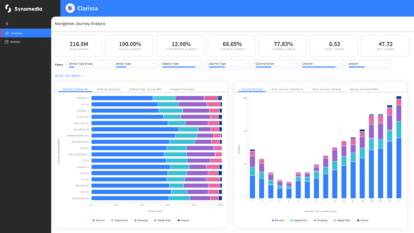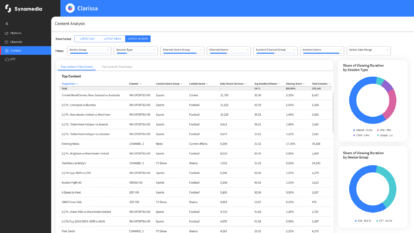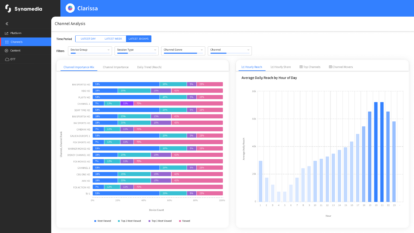The broadcast and streaming industry is at a crossroads. For decades, the television experience was defined by the set-top box (STB) – rigid, expensive hardware that necessitated long development cycles and proprietary coding languages.
Today, the most critical question facing every operator and content publisher is no longer if they can compete with Netflix, but how they can do so without crippling their budget and suffocating their speed.
The answer is simple: stop treating the TV experience like a piece of bespoke electronics, and start treating it like an extension of your website.
By shifting your TV User Interface (UI) to a cloud-based, web-first platform like Synamedia Senza, you immediately unlock three powerful commercial benefits. Crucially, you achieve this by empowering the web development and product teams you already employ, turning your platform from a costly bottleneck into a dynamic, self-funding revenue engine.
1. The Revenue Uplift: Monetisation Like Your Website
The most immediate and compelling reason to move to a web stack is money. The web is the most mature, profitable advertising ecosystem in the world, yet legacy STB platforms prevent operators from accessing its full potential.
A web UI platform changes everything because it natively supports modern, high-value ad formats and standards:
- Dynamic Ad Insertion (DAI): Legacy systems struggle with smooth, personalised ad insertion, leading to frustrating loading screens and dropped ad spots. Synamedia Senza’s web foundation handles Server-Side Ad Insertion (SSAI) seamlessly. This means ads are stitched directly into the video stream before it reaches the viewer, creating a TV experience free from those annoying pauses. This dramatically increases your Ad Fill Rate, as ad blockers struggle to distinguish the ads from the main programme, converting previously lost impressions into guaranteed revenue.
- Net-New Inventory: On an old system, you’re limited to linear ad breaks. A web-based UI allows you to create entirely new, high-attention inventory spots using standard HTML and CSS overlays. Think about Pause Ads – a branded, interactive ad that appears when a user pauses the content. This is a 100% net-new revenue stream that costs virtually nothing to implement but guarantees viewer attention.
- Interactive Formats: Why limit yourself to static video ads? The web allows for clickable buttons, QR codes, and interactive overlays within ads, connecting viewers directly to e-commerce, sign-up forms, or partner content. These highly measurable direct-response ads command premium prices, boosting your effective CPM (Cost Per Mille) and rapidly paying for the platform’s running costs.
In short, your TV platform finally gets to play by the rules of the premium web advertising market.
2. Analytics: Getting the Data You Need, Simply
If you run an e-commerce site or a news portal, you have instant access to rich analytics – where people click, how long they stay, and what causes them to drop off. With legacy STBs, this level of granular, real-time data collection is often expensive, slow, or impossible.
The web-first approach solves this by allowing you to integrate the same market-leading analytics tools you use everywhere else.
- Plug-and-Play Tracking: Because the Synamedia Senza UI is essentially a web page, you can plug in Google Analytics, Adobe Analytics, or any bespoke tracking solution with minimal friction. Your existing data teams can use the familiar dashboards and metrics they rely on for every other digital property.
- Real-Time UX Optimisation: If you roll out a new menu design and tracking shows that viewers are struggling to find content, you know instantly. You can A/B test two different UI layouts simultaneously and pivot instantly to the winner – all within minutes, not months. This speed means you constantly optimise the user experience, which is the single most effective way to reduce subscriber churn and protect your subscription revenue.
- Audience Segmentation: The rich, accurate data collected via the web allows for super-targeted advertising. Instead of showing a generic ad to millions, you can show a sports car ad only to verified high-net-worth viewers who watched the Formula 1 highlights. This level of precision doesn’t just improve ad yield — it strengthens partnerships with advertisers and content brands.
3. Agility: Empowering the Teams You Already Have
The greatest hidden cost of legacy TV systems is the bottleneck on innovation. Every time a change is needed, it requires specialised native developers, bespoke coding, and a lengthy certification process that holds the business back.
By moving to a web-based platform, you achieve agility through familiarity:
- Use Standard Talent: You eliminate the need to hire scarce, expensive native developers. Your product and UI teams, who already speak JavaScript, React, and HTML, become instantly productive on the new TV platform.
- Launch in Minutes, Not Months: You can treat the TV UI like any other web release. New features or branding updates can be deployed instantly, just a simple F5 refresh, and your changes are live.
- Reduced Cost, Greater Speed: You dramatically shrink your Operational Expenditure (OpEx) on development by consolidating your teams onto a single, universal, flexible codebase. Your teams move from maintenance mode to growth mode.
Ultimately, shifting to a web stack is not just a technology choice; it’s a fundamental commercial decision. It turns your platform’s UI from a rigid financial liability into an agile, data-rich asset that maximises both your advertising revenue and your subscription revenue, ensuring your business is always ahead of the competition.
To explore how Synamedia Senza can help transform your platform, get in touch with us through our contact form.
About the Author
Sally Nelson is qualified in engineering and marketing disciplines, with a proven track record of bringing successful products to market across multiple industries and regions. She recently joined Synamedia as Product Manager for Synamedia Senza, leveraging over 20 years of experience in product leadership roles at Roku, Amino Communications, and Telstra. Sally holds a Bachelor of Engineering from Newcastle University and a Certificate in Marketing from the Chartered Institute of Marketing. She specializes in driving product innovation and growth in the streaming and media technology sectors.












